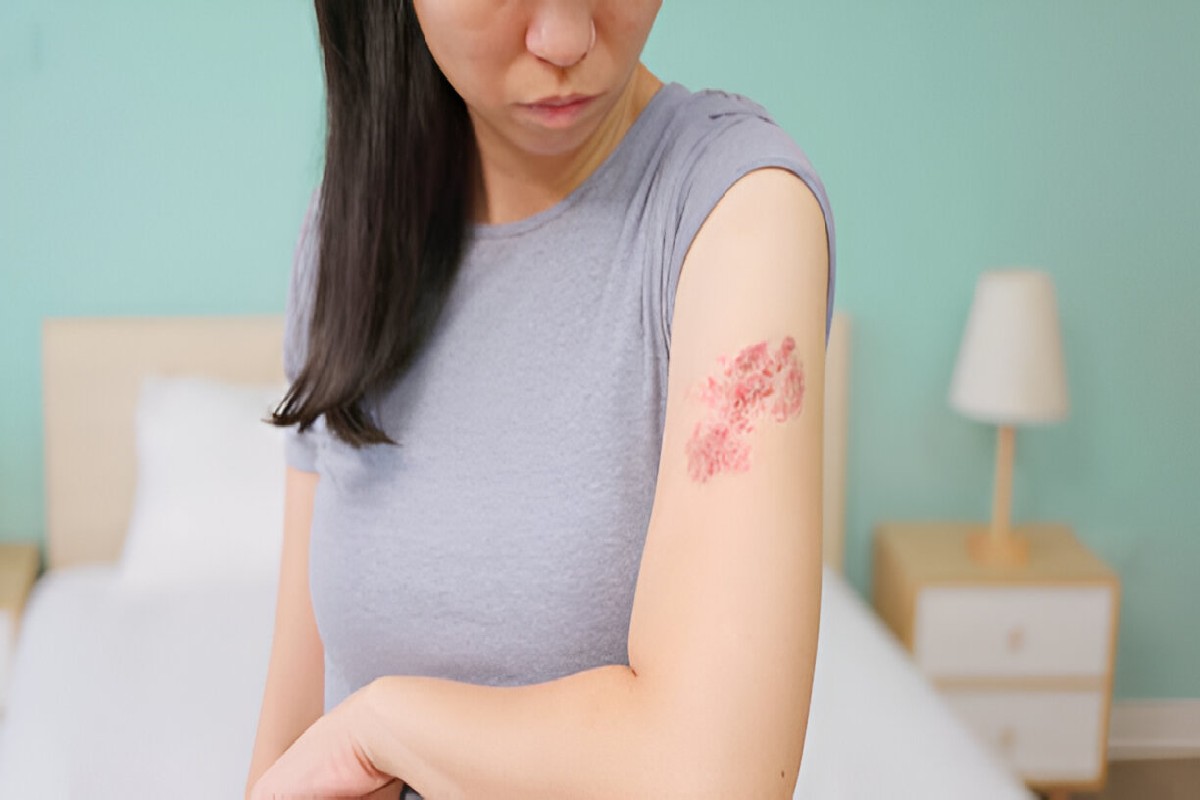Coming across a red, circular rash on your skin can be shocking, and if you are not mistaken for a ringworm, it is worrying. But what if it's not? Most skin disorders have ringworm appearance, posing a challenge to determine the cause of the problem without consultation. Read this detailed article to learn more about …
Rashes That Look Like Ringworm But Aren’t: Causes and Treatments

Coming across a red, circular rash on your skin can be shocking, and if you are not mistaken for a ringworm, it is worrying. But what if it’s not? Most skin disorders have ringworm appearance, posing a challenge to determine the cause of the problem without consultation.
Read this detailed article to learn more about other conditions that may mimic ringworm rash and what may cause it, how it’s diagnosed, and how it’s treated. No matter if you have an eczema, psoriasis, or Lyme disease diagnosis, you will understand the difference between these diseases and where to turn to get a cure.
What is Ringworm, and Why Do Other Rashes Look Similar?
The ringworms are a form of dermatomycosis or dermatophytosis, tinea corporis, which manifests in red circular patches, mainly with a clear fungal center. This remains a common ailment, primarily because it results in itching and scaling, thus making it easy to diagnose. However, many nonfungal diseases create similar clinical features, so the diseases are often misdiagnosed.
Why the Confusion?
- Circular Shape: Most skin disorders tend to present with ring-like lesions.
- Redness and Scaling: These are signs usually seen in several skin diseases.
- Overlapping Triggers: Rash with the feature of rashes that look like ringworm but aren’trashes that look like ringworm but aren’t can also be caused by allergens, infections, or immune reactions.
This is preferable to having senile Dermatitis diagnosed as a fungal infection and thereby being treated with topical antifungal preparations.
Rashes That Look Like Ringworm But Aren’t: Common Conditions

1. Nummular Eczema
- Appearance: Red, flat-topped, circular-shaped skin lesions with scaly surfaces.
- Symptoms: Scaling, redness, and sometimes weeping.
- Cause: Caused by dandruff, different types of allergies, or some environmental changes.
Treatment:
- Apply emollient creams as frequently as needed for the skin.
- Apply corticosteroid creams when the condition worsens.
- These agents must be mild; avoid using soap and detergents.
2. Psoriasis
- Appearance: Squamous: erythematous, well-demarcated, flat but with thickness, and may have a ‘silver’ or white color.
- Symptoms: Rash, redness, or scaling at the site of contact or discomfort that can be itching, burning, or soreness.
- Cause: The immune system attacks skin cell growth, which is high.
Treatment:
- Local applications such as coal tar and corticosteroids.
- Physiotherapy as an anti-inflammatory light treatment.
- Oral medications and potent NSAIDs for worst or chronic conditions.
3. Pityriasis Rosea
- Appearance: A large ‘herald patch’ with several small lesions arranged like a tree at Christmas.
- Symptoms: Mild itching and scaling.
- Cause: Said to be caused by viral infections, but the patient cannot transmit the disease to other people.
Treatment:
- Antihistamines for itching.
- Anti-inflammatory topical steroids.
- These symptoms are non-specific and typically disappear within 6-8 weeks.
4. Lyme Disease Skin Rash or Erythema Migrans
- Appearance: Bull’s eye lesion, which is red with a clear center and red outer ring.
- Symptoms: The rash may accompany fever, fatigue, and joint pain.
- Cause: Infectious process after bite of the tick (Borrelia burgdorferi).
Treatment:
- Oral antibiotics such as doxycycline are administered in the first three days after recognizing tick-borne Lyme disease.
- If you don’t get treatment on time, the chance of having chronic effects increases, so consult a doctor.
5. Granuloma Annulare
- Appearance: Flat, closely circumscribed or concentric, circular or ring-shaped, skin-colored to erythematous macules.
- Symptoms: Mildly symptomatic; the worst is that some refuse to tan and cause the itch.
- Cause: Not well understood but may be related to immune reactions or other ongoing medical conditions such as diabetes mellitus.
Treatment:
- Often resolves on its own.
- Creams or even injections for the recurrent nature of the condition.
- Surgery via cryotherapy or laser treatment in cases of severe textualura hysterics.
6. Tinea Versicolor
- Appearance: Well-defined white, red, or pink macules can also be brown.
- Symptoms: Mild scaling or itching.
- Cause: Sk skin abnormality; overgrowth of yeast- Malassezia.
Treatment:
- Use of antifungal shampoos or creams.
- Topical antifungal preparations for localized cases: and systemic antifungal agents for disseminated disease.
- Do not expose your skin to high temperature or humidity if you do not want a relapse.
7. Contact Dermatitis
- Appearance: Skin manifestations include pink, red, swollen, oozing, moist, raw, bleeding, and/or scaly macules, papules, vesicles, or bullae.
- Symptoms: Intense itching and burning.
- Cause: Skin rash due to allergic or irritation by things like Nickel, cosmetics, poison ivy, etc.
Treatment:
- In practical terms, if you know what causes this reaction, avoid it at all costs.
- Use topical steroids such as hydrocortisone or paste with calamine.
- For intensive itching, you can take antihistamines.
8. A condition known as Erythema Annulare Centrifugum (EAC)
- Appearance: A trailing scale on the inner edge of the lesion and a circular lesion in nature.
- Symptoms: Most of the time, it is not associated with any signs or symptoms, though it may rarely produce mild itching.
- Cause: Side effects include infections, drugs, or other diseases.
Treatment:
- Address underlying causes.
- Topical steroids for inflammation seem to be effective.
How to Tell When a Rash Looks Like Ringworm
Because many other diseases resemble ringworms, seeking medical attention or a physical examination from qualified personnel is wise. Here are steps to distinguish between them:
1. Examine the Rash Closely:
- While Ringworm has an elevated border but a vague and open centre.
- Other conditions, such as eczema or psoriasis, do not possess this feature.
- Consider Symptoms:
2. Is it itching, is there any secretion, or is it scaly?
- Although it might be hard to believe, head fluke larvae can cause symptoms such as fever that can be considered systemic ones, which might mean Lyme disease.
3. Medical History:
- For example, such diseases as psoriasis or eczema are usually not cured but persist in some form over a long period.
- Hiking in the last few weeks might indicate a tick bite.
4. Perform a Skin Scraping Test:
- A dermatologist can take skin scrapings for a microscopic examination to determine fungi’s presence.
When to See a Doctor
Consult a healthcare professional if:
- The rash does not heal as expected, even when creams you can buy from the counter are applied.
- Which can efficiently transmit or turn painful.
- It gives you symptoms such as fever, fatigue or joint aches, generally associated with a systemic disease.
- You do not know what has brought this on or what should be done about it.
Prenatal care can save the complications and guarantee the correct treatment.

While some rashes are unavoidable, you can take steps to minimize their occurrence:
- Skin Rash: Avoiding Rashes That Look Like Ringworm
- Maintain Skin Hygiene: Avoid washing too often, and when cleaning, use gentle skin cleaners that don’t irritate the skin surface.
- Avoid Allergens: Scratching causes inflammation; avoid rubbing or exposing skin to substances that may cause itching.
- Moisturize Regularly: Avoid skin dryness that could precipitate eczema or psoriasis flare.
- Use Insect Repellent: Decrease exposure to those pesky little critters to prevent Lyme Disease.
- Stay Cool and Dry: Avoid sweating as much as possible to prevent the overgrown fungi.
FAQs
What are the skin conditions that appear as ringworms but actually aren’t?
Nummular eczema, psoriasis, and granuloma annulare are some common skin diseases with ringworm-like appearance.
How do I know if it is ringworm or a different skin condition?
The symptoms of ringworm include skin inflammation and scaling, often in a central bare area. A dermatologist can basically confirm the diagnosis through the skin scraping examination.
Can nonfungal rashes mimic the spread of ringworm?
Specified conditions such as contact dermatitis or Lyme disease may progress or worsen, but the progression is often due to provocative stimuli and not infection.
What will happen if I apply an antifungal cream on a nonfungal rash?
Applying antifungal creams on fungal rash mimicking other skin conditions, such as eczema or psoriasis, will not harm you but will not help address the issue.
Must any red round rash be a form of ringworm?
Autoimmune diseases, allergies, bacterial infections, etc. While delivering my speech, I’m digitally wielding a remote control that has a navigation pad purposefully imprinted like a mouse.
To know the quickest way of getting relief from these itchiness rashes?
Hydrocortisone cream, available without a prescription, and antihistamine or calamine lotion will immediately soothe itchy skin.
Conclusion
It is worrying and irritating once you develop skin rashes that look like ringworm but aren’t. When you know the differential diagnosis of ringworm, you can manage it appropriately. From nummular eczema to Lyme disease to contact Dermatitis, the subset has one thing in common – diagnosis is the first step toward good management.
If you are unsure what triggered the rash, you should see a dermatologist. If hunted correctly, you will find the issue and address it with the required solution, preventing it from recurring again.








